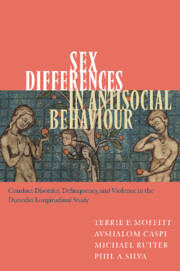 Sex Differences in Antisocial Behaviour
Sex Differences in Antisocial Behaviour Book contents
- Frontmatter
- Contents
- List of figures
- List of tables
- Preface
- Acknowledgements
- 1 Introduction
- 2 The Dunedin Multidisciplinary Health and Development Study
- 3 Sex differences in the amount of antisocial behaviour: dimensional measures
- 4 Sex differences in the prevalence of antisocial behaviour: categorical diagnostic measures
- 5 Sex differences in physical violence and sex similarities in partner abuse
- 6 Sex and the developmental stability of antisocial behaviour
- 7 Sex and the age of onset of delinquency and conduct disorder
- 8 Sex effects in risk predictors for antisocial behaviour: are males more vulnerable than females to risk factors for antisocial behaviour?
- 9 Sex effects in risk predictors for antisocial behaviour: are males exposed to more risk factors for antisocial behaviour?
- 10 Can sex differences in personality traits help to explain sex differences in antisocial behaviour?
- 11 Sex and comorbidity: are there sex differences in the co-occurrence of conduct disorder and other disorders?
- 12 Do girls who develop antisocial behaviour surmount a higher threshold of risk than their male counterparts?
- 13 Sex differences in the effects of antisocial behaviour on young adult outcomes
- 14 Sex, antisocial behaviour, and mating: mate selection and early childbearing
- 15 Evaluating the recommendation to relax the criteria for diagnosing conduct disorder in girls
- 16 Life-course persistent and adolescence-limited antisocial behaviour among males and females
- 17 Priorities for a research agenda
- References
- Index
6 - Sex and the developmental stability of antisocial behaviour
Published online by Cambridge University Press: 22 September 2009
- Frontmatter
- Contents
- List of figures
- List of tables
- Preface
- Acknowledgements
- 1 Introduction
- 2 The Dunedin Multidisciplinary Health and Development Study
- 3 Sex differences in the amount of antisocial behaviour: dimensional measures
- 4 Sex differences in the prevalence of antisocial behaviour: categorical diagnostic measures
- 5 Sex differences in physical violence and sex similarities in partner abuse
- 6 Sex and the developmental stability of antisocial behaviour
- 7 Sex and the age of onset of delinquency and conduct disorder
- 8 Sex effects in risk predictors for antisocial behaviour: are males more vulnerable than females to risk factors for antisocial behaviour?
- 9 Sex effects in risk predictors for antisocial behaviour: are males exposed to more risk factors for antisocial behaviour?
- 10 Can sex differences in personality traits help to explain sex differences in antisocial behaviour?
- 11 Sex and comorbidity: are there sex differences in the co-occurrence of conduct disorder and other disorders?
- 12 Do girls who develop antisocial behaviour surmount a higher threshold of risk than their male counterparts?
- 13 Sex differences in the effects of antisocial behaviour on young adult outcomes
- 14 Sex, antisocial behaviour, and mating: mate selection and early childbearing
- 15 Evaluating the recommendation to relax the criteria for diagnosing conduct disorder in girls
- 16 Life-course persistent and adolescence-limited antisocial behaviour among males and females
- 17 Priorities for a research agenda
- References
- Index
Summary
How stable is antisocial behaviour? Even in the 1970s, during the heyday of ‘situationism’ in psychology, behavioural scientists acknowledged that individual differences in aggressive behaviour are stable (Olweus, 1979). Longitudinal studies completed both before and after Olweus' review showed that antisocial behaviour was predictable from one point in time to another (e.g., Huesmann et al., 1982; Farrington, 1986; Macfarlane, Allen, and Honzik, 1954; Stattin and Magnusson, 1991b; Pulkinnen and Pitkanen, 1993; Patterson, Reid, and Dishion, 1992; Stanger, Achenbach, and Verhulst, 1997). However, most of the studies of the stability of antisocial behaviour have examined only males because historically few longitudinal studies of antisocial behaviour have sampled girls; in fact, the two most oftcited authoritative reviews on the topic of the stability of antisocial behaviour reviewed studies of males only (Loeber, 1982; Olweus, 1979). Some authors state that antisocial behaviour is less stable and predictable among females than among males (e.g., Cairns and Cairns, 1984; Moss and Susman, 1980), while other authors state that there is no reliable sex difference in the stability of antisocial behaviour (Cairns and Cairns, 1994; Tremblay et al., 1992). In our reading of the literature, we were impressed at how often each view was stated with confidence. Both cannot be correct.
The goal of this chapter is to test whether antisocial behaviour is equally stable from childhood to adolescence to adulthood in both males and females.
- Type
- Chapter
- Information
- Sex Differences in Antisocial BehaviourConduct Disorder, Delinquency, and Violence in the Dunedin Longitudinal Study, pp. 71 - 80Publisher: Cambridge University PressPrint publication year: 2001
- 1
- Cited by


